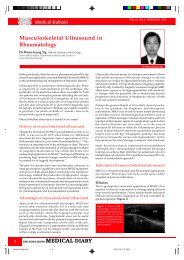MEDICAL DIARY - The Federation of Medical Societies of Hong Kong
MEDICAL DIARY - The Federation of Medical Societies of Hong Kong
MEDICAL DIARY - The Federation of Medical Societies of Hong Kong
You also want an ePaper? Increase the reach of your titles
YUMPU automatically turns print PDFs into web optimized ePapers that Google loves.
8<br />
<strong>Medical</strong> Bulletin<br />
Absence <strong>of</strong> resting ECG abnormality that precludes<br />
accurate exercise ECG assessment (for example,<br />
LBBB)<br />
Since clinical presentation, the patient:<br />
remains asymptomatic<br />
with improving chest pain symptoms<br />
with persistent atypical chest pain symptoms<br />
Absence <strong>of</strong> typical ischaemic chest pain at the time <strong>of</strong><br />
exercise testing 12<br />
Treadmill stress ECG examination provides reliable<br />
prognostic information for low risk patients with test<br />
performed within 48 hours <strong>of</strong> clinical presentation:<br />
Positive or equivocal examination result�15% six<br />
month event rate<br />
Negative examination result�2% six month event<br />
rate11<br />
Treadmill stress ECG examination is very safe. In my<br />
over 15 years' experience (Lucky?!), I do not have a<br />
single case <strong>of</strong> morbidity and mortality for my chest<br />
pain patients. Still, there are some contraindications<br />
that need to be observed carefully:<br />
- New or evolving resting ECG abnormalities<br />
- Abnormal Cardiac blood markers<br />
- Inability to perform treadmill exercise (neurological<br />
and lower limb musculoskeletal disease)<br />
- Worsening <strong>of</strong> chest pain symptoms since presentation<br />
- Clinical risk pr<strong>of</strong>iling indicating imminent coronary<br />
angiography is indicated 12<br />
Imaging Tests<br />
Imaging tests are good for chest pain patients who<br />
cannot perform treadmill stress ECG examination or<br />
their resting ECG abnormality affecting the accuracy <strong>of</strong><br />
Treadmill ECG interpretation (for example. LBBB)<br />
Resting Echocardiogram<br />
Stress Echocardiogram (Exercise/Dobutamine)<br />
Nuclear Myocardial Perfusion Scan (Resting + Stress)<br />
CT coronary angiogram<br />
MRI myocardial perfusion and anatomy scan<br />
In general they have the following characteristics:<br />
More sensitive and specific<br />
Ability to quantify the degree and extent <strong>of</strong> ischaemia<br />
Expensive (From a few thousand to over ten<br />
thousand <strong>Hong</strong> <strong>Kong</strong> Dollars per each examination)<br />
Invasive (except resting echocardiogram)<br />
Less readily available<br />
Each test is different in their strong and weak areas,<br />
price, indication and the degree <strong>of</strong> invasiveness. <strong>The</strong><br />
technology is also advancing in light speed. New data<br />
keep popping up every month. I would like to sincerely<br />
ask my family practice colleagues to consult their<br />
cardiologist friends before booking.<br />
Local Chest Pain Management<br />
Guidelines for Family Doctors<br />
~ My Humble Suggestions (With<br />
Reference to the Updated ACC/AHA<br />
Guidelines 2002').<br />
VOL.14 NO.1 JANUARY 2009<br />
This following is my favourite table. I have modified it<br />
from the AHA/ACC statement for our local use. It can<br />
help you to point out the likely signs and symptoms<br />
towards or the likelihood <strong>of</strong> ACS (unstable angina and<br />
acute mycocardial infarction) 13<br />
Table 2<br />
Features<br />
History<br />
Examination<br />
ECG<br />
Cardiac<br />
Markers<br />
High likelihood<br />
(Any <strong>of</strong> the Following)<br />
Chest or left arm<br />
discomfort<br />
reproducing prior<br />
documented angina<br />
Hx <strong>of</strong> IHD/AMI<br />
Mitral Regurgitation<br />
�BP<br />
Cold Sweating<br />
Pulmonary oedema<br />
New ST elevation<br />
1mm<br />
New T wave<br />
inversion 4mm<br />
�Cardiac Troponin I<br />
�Cardiac Troponin T<br />
�CKMB<br />
Intermediate<br />
Likelihood<br />
(Absence <strong>of</strong> High-<br />
Likelihood Features<br />
and Presence <strong>of</strong> any <strong>of</strong><br />
the Following)<br />
Chest or left arm<br />
discomfort<br />
Age > 70<br />
Male<br />
DM<br />
Extacardiac vascular<br />
disease<br />
Eg. PVD, Stroke<br />
Fixed Q waves<br />
Old Abnormal ST<br />
segments or T waves<br />
Normal<br />
Low Likelihood<br />
(Absence <strong>of</strong> High- or<br />
Intermediate-<br />
Likelihood Features<br />
and Presence <strong>of</strong> any<br />
<strong>of</strong> the Following)<br />
Probable ischaemic<br />
symptoms in the<br />
absence <strong>of</strong> the<br />
intermmediate and<br />
high likelihood<br />
characteristics<br />
Chest discomfort<br />
reproduced by<br />
palpitation<br />
T wave flattening<br />
in leads with tall R<br />
waves<br />
Normal ECG<br />
Normal<br />
This is my second beloved table. I have also modified it<br />
from the AHA/ACC statement for our local use. Once<br />
your diagnosis is ACS, it can help you to further risk<br />
stratify your patient. That is the likelihood <strong>of</strong> your<br />
patient, heading towards catastrophic results (Death or<br />
Nonfatal Myocardial Infarction) 13<br />
<strong>The</strong> Short Term Likelihood <strong>of</strong> Death or<br />
Nonfatal Myocardial Infarction in<br />
Unstable Angina Patients 13<br />
Table 3<br />
Feature<br />
History<br />
Pain<br />
Character<br />
Clinical<br />
findings<br />
ECG<br />
Cardiac<br />
Markers<br />
High likelihood<br />
(Any <strong>of</strong> the following)<br />
Accelerating tempo <strong>of</strong><br />
ischaemic symptoms<br />
in the preceding<br />
48hours<br />
Resting angina ><br />
20mins<br />
Pulmonary oedema<br />
New or worsening<br />
mitral regurgitations<br />
S3/Gallop rhythm,<br />
Lung crepitations<br />
�BP, �HR, �HR<br />
Age > 75<br />
Resting angina with<br />
ST elevation > 1mm<br />
new/presumed new<br />
BBB<br />
Sustained VT<br />
�Cardiac Troponin T<br />
> 0.1ng/ml<br />
Intermediate<br />
Likelihood<br />
(Absence <strong>of</strong> Highlikelihood<br />
Features &<br />
presence <strong>of</strong> any <strong>of</strong> the<br />
Following)<br />
History <strong>of</strong> MI, PVD,<br />
CVA, CABG, Aspirin<br />
usage<br />
resolved Resting<br />
angina > 20mins with<br />
moderate or high<br />
likelihood <strong>of</strong> CAD<br />
Resting angina <<br />
20mins, relieved by<br />
rest/TNG<br />
Age > 70<br />
T wave inversion<br />
> 4mm<br />
Q waves<br />
Slightly elevated<br />
�Cardiac Troponin T<br />
> 0.01ng/ml 20mins<br />
resting angina, with<br />
with moderate or<br />
high likelihood <strong>of</strong><br />
CAD<br />
Normal/Unchanged<br />
ECG during chest<br />
pain<br />
Normal<br />
<strong>The</strong> following are my humble suggestions for my dearest<br />
family practice and non-cardiac specialty colleagues:

















